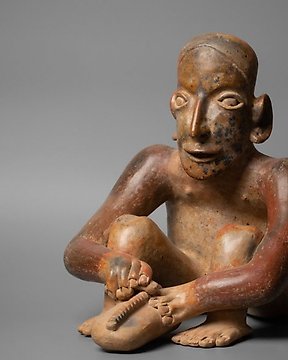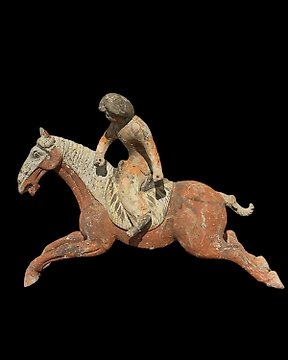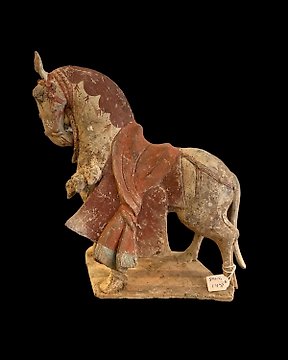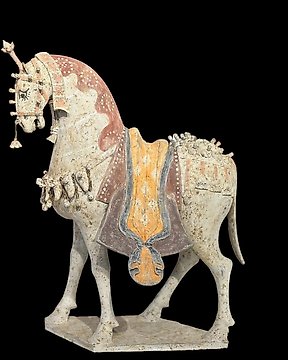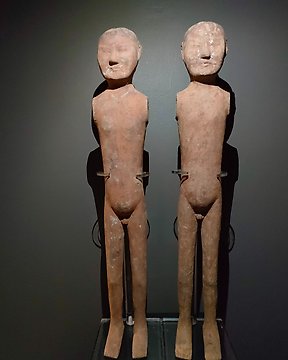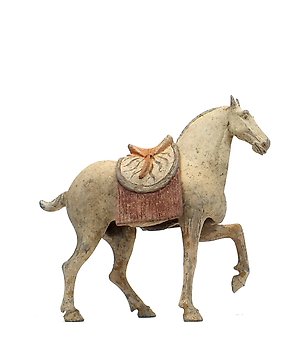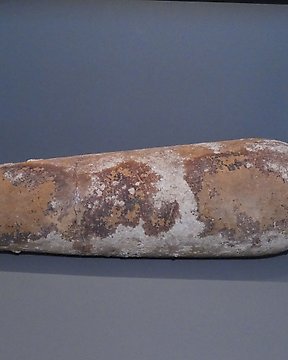Object is beautiful and in good condition Thank you
Ver traduzidoAncient Chinese, Tang Dynasty Terracota Cavalo Grande com TESTE QED TL - 62 cm
N.º 85297525
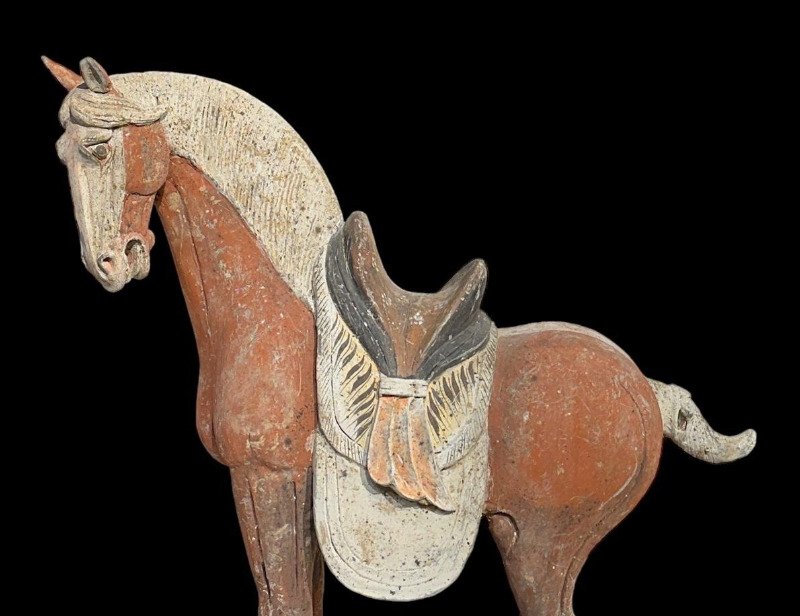
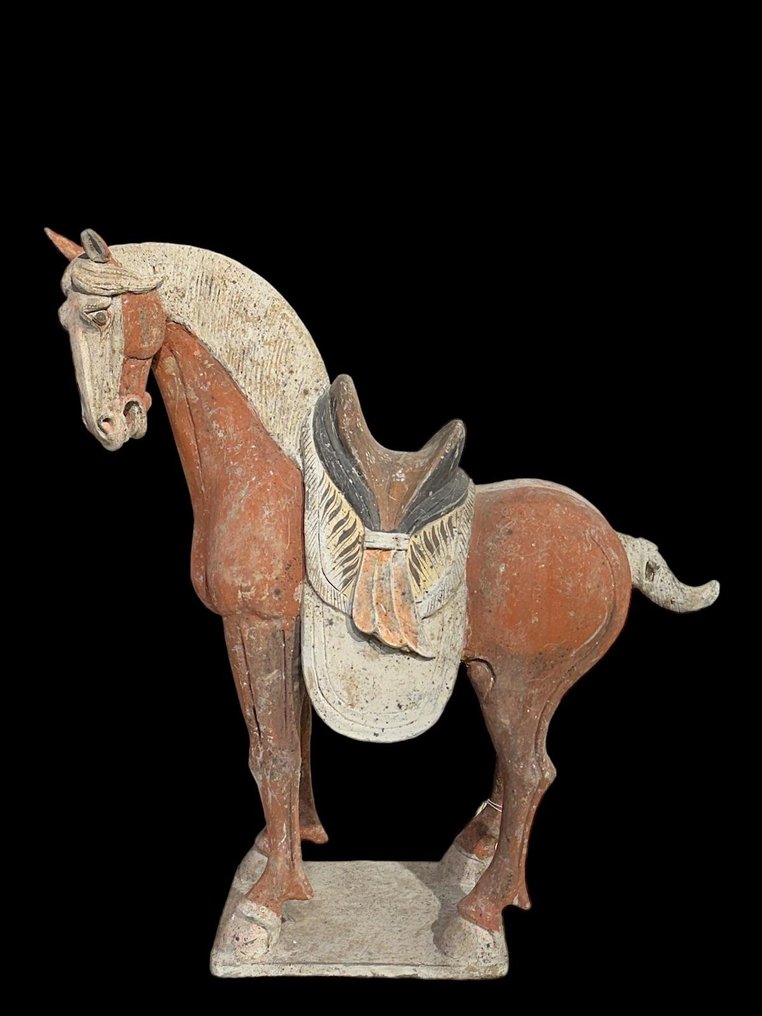



Horse; China, Tang Dynasty, AD 618-906.
Polychrome terracotta.
Thermoluminescence certificate enclosed.
Measurements: 62 x 60 x 20 cm.
Figure of a horse, made in polychrome terracotta, probably with the usual engobes of the period (cold-applied), which may have formed part of a funerary trousseau of a prominent member of the Tang Dynasty. It is notable for the naturalistic way in which the artist has portrayed it, capturing the face in detail and adopting a position through the open legs, with the head turned. The Tang dynasty is considered by historians to be a period of splendour in Chinese civilisation, equal or even superior to the Han period. Emerging after a period of despotism under the cruel Yang Di, it was established by Li Shimin who, out of filial piety, put his father on the throne before assuming the role of emperor himself and founding the Tang dynasty. Stimulated by contact with India and the Middle East via the Silk Road, the Tang empire experienced a creative boom in many fields. Buddhism, which had emerged in India at the time of Confucius, continued to flourish during this period and was adopted by the imperial family, becoming an essential part of traditional Chinese culture. The development of the printing press also extended the dissemination of written works, giving rise to the golden age of Chinese art and literature, and the great cultural opening up resulted in a fundamentally colourful, expressive and highly eclectic art, although it remained primarily for funerary use, with the artist remaining an anonymous craftsman. However, from this time onwards, high-fired ceramics, decorated with enamels, would come to be used as a status symbol, with typologies such as vessels for the table of the litterateur and all types of tableware. Terracotta, on the other hand, continued to be used for grave goods, although stoneware would also be used from now on, especially for the tombs of nobles and scholars. In funerary pieces, the group to which these bears belong, an important novelty was introduced: tricolour lead glazes (sancai), although pieces decorated with engobes continued to be made. Among the grave goods, there are six typological groups, each with a great variety: tomb guardians, with warriors and protective beasts; ceremonial figures with their servants; animals of all kinds, such as oxen, camels and horses; musicians and court ladies; utensils and vessels; and finally, architectural models. Three periods can also be distinguished. The first of these, between 681 and 683, is dominated by figures decorated with engobes, but not yet glazed, so that the pieces presented here could be dated to between these years. The second period, between 683 and 779, is the great Sancai period, with a predominance of enamel. Finally, until the beginning of the 10th century, pieces with Sancai enamels continued to be made, albeit of lower quality than those of the previous period.
Condition: Good condition, restoration is observed on the ears and one of them is missing the tip. (TO SEE PHOTOS). Earthy deposits on the surface.
Provenance: M. L. F. Private Collection, Madrid. Purchased from an antique dealer in Hong Kong.
Notes: The piece includes a Spanish Export License (Passport for the European Union), at the time of sale it is requested in the name of the buyer, the process takes 2 to 4 weeks. - If the piece is destined outside the European Union, a replacement of the export permit will be requested. This procedure entails fee expenses that the buyer must pay during the application process. This process can take 4 to 6 weeks. SHIPPED WITH INSURANCE
The transportation price is estimated and ultimately depends on the type of packaging, size and weight of the boxes. The buyer will be informed of the final shipping price and will be asked for the difference or paid the difference.
Important: If the piece travels to Asia, transportation costs may vary significantly due to the current situation.
Important information. The seller guarantees that he has the right to ship this lot.
The seller will ensure that the necessary permits are processed.
The seller will inform the buyer about this if it takes more than a few days.
Mais sobre o vendedor
Horse; China, Tang Dynasty, AD 618-906.
Polychrome terracotta.
Thermoluminescence certificate enclosed.
Measurements: 62 x 60 x 20 cm.
Figure of a horse, made in polychrome terracotta, probably with the usual engobes of the period (cold-applied), which may have formed part of a funerary trousseau of a prominent member of the Tang Dynasty. It is notable for the naturalistic way in which the artist has portrayed it, capturing the face in detail and adopting a position through the open legs, with the head turned. The Tang dynasty is considered by historians to be a period of splendour in Chinese civilisation, equal or even superior to the Han period. Emerging after a period of despotism under the cruel Yang Di, it was established by Li Shimin who, out of filial piety, put his father on the throne before assuming the role of emperor himself and founding the Tang dynasty. Stimulated by contact with India and the Middle East via the Silk Road, the Tang empire experienced a creative boom in many fields. Buddhism, which had emerged in India at the time of Confucius, continued to flourish during this period and was adopted by the imperial family, becoming an essential part of traditional Chinese culture. The development of the printing press also extended the dissemination of written works, giving rise to the golden age of Chinese art and literature, and the great cultural opening up resulted in a fundamentally colourful, expressive and highly eclectic art, although it remained primarily for funerary use, with the artist remaining an anonymous craftsman. However, from this time onwards, high-fired ceramics, decorated with enamels, would come to be used as a status symbol, with typologies such as vessels for the table of the litterateur and all types of tableware. Terracotta, on the other hand, continued to be used for grave goods, although stoneware would also be used from now on, especially for the tombs of nobles and scholars. In funerary pieces, the group to which these bears belong, an important novelty was introduced: tricolour lead glazes (sancai), although pieces decorated with engobes continued to be made. Among the grave goods, there are six typological groups, each with a great variety: tomb guardians, with warriors and protective beasts; ceremonial figures with their servants; animals of all kinds, such as oxen, camels and horses; musicians and court ladies; utensils and vessels; and finally, architectural models. Three periods can also be distinguished. The first of these, between 681 and 683, is dominated by figures decorated with engobes, but not yet glazed, so that the pieces presented here could be dated to between these years. The second period, between 683 and 779, is the great Sancai period, with a predominance of enamel. Finally, until the beginning of the 10th century, pieces with Sancai enamels continued to be made, albeit of lower quality than those of the previous period.
Condition: Good condition, restoration is observed on the ears and one of them is missing the tip. (TO SEE PHOTOS). Earthy deposits on the surface.
Provenance: M. L. F. Private Collection, Madrid. Purchased from an antique dealer in Hong Kong.
Notes: The piece includes a Spanish Export License (Passport for the European Union), at the time of sale it is requested in the name of the buyer, the process takes 2 to 4 weeks. - If the piece is destined outside the European Union, a replacement of the export permit will be requested. This procedure entails fee expenses that the buyer must pay during the application process. This process can take 4 to 6 weeks. SHIPPED WITH INSURANCE
The transportation price is estimated and ultimately depends on the type of packaging, size and weight of the boxes. The buyer will be informed of the final shipping price and will be asked for the difference or paid the difference.
Important: If the piece travels to Asia, transportation costs may vary significantly due to the current situation.
Important information. The seller guarantees that he has the right to ship this lot.
The seller will ensure that the necessary permits are processed.
The seller will inform the buyer about this if it takes more than a few days.
Mais sobre o vendedor
- 3
- 1
- 0
Received my parcel in great condition. Very well taken care of. Thank you!
Ver traduzidoTrès bel objet, livré dans l'appartement, parfait
Ver traduzidoA embalagem era desadequada porque não garantiu a preservação da peça. Verficou-se a quebra de uma parte da peça.
Ver traduzido- 3
- 1
- 0
Object is beautiful and in good condition Thank you
Ver traduzidoAviso Legal
O vendedor garante e pode provar que o objeto foi obtido legalmente. O vendedor foi informado pela Catawiki que tinha de fornecer a documentação exigida pelas leis e regulamentos do seu país de residência. O vendedor garante que tem o direito de vender/exportar este objeto. O vendedor fornecerá ao comprador toda a informação conhecida sobre a proveniência do objeto. O vendedor garante que serão ou já foram obtidas todas as autorizações necessárias. O vendedor informará imediatamente o comprador de quaisquer atrasos na obtenção de tais autorizações.
O vendedor garante e pode provar que o objeto foi obtido legalmente. O vendedor foi informado pela Catawiki que tinha de fornecer a documentação exigida pelas leis e regulamentos do seu país de residência. O vendedor garante que tem o direito de vender/exportar este objeto. O vendedor fornecerá ao comprador toda a informação conhecida sobre a proveniência do objeto. O vendedor garante que serão ou já foram obtidas todas as autorizações necessárias. O vendedor informará imediatamente o comprador de quaisquer atrasos na obtenção de tais autorizações.
